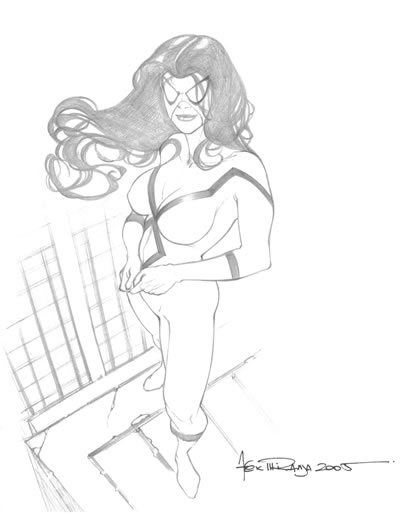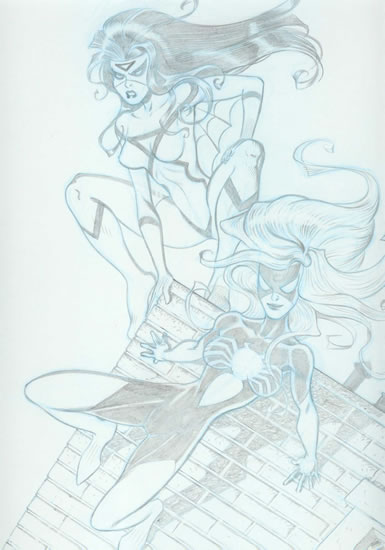I Love the '70s: Superheroine Edition
Ah, the 1970s. We may never again see as maddeningly uncertain or as bizarrely self-possessed a period in American history. Although I was born in the 1960s -- 1961, to be exact -- culturally speaking, I'm a child of the '70s, because that's the decade in which I came of age. I spent those giddy years of my hormonal adolescence trotting the globe, living variously in Europe (on the Greek island of Crete), Southeast Asia (on the Philippine island of Luzon), and North America (on the virtual island of California). That's not even counting that interminable year I endured in Abilene, Texas. But my therapist doesn't allow me to talk about that.
I also spent those years reading comic books. Hundreds, perhaps thousands, of comic books.
Thanks to the then-burgeoning Women's Liberation movement, the '70s were a fertile time for superheroines in comics. In a field long dominated -- and for a number of years in the '50s, exclusively populated -- by Wonder Woman, suddenly hyperpowered babes in spandex (and sometimes less) were everywhere. Many in this new generation of superwomen were merely distaff versions of existing male superheroes, as the Batgirl introduced in the 1960s had been. Others, however, including Storm of the newly revived and revamped X-Men, brought fresh powers and personalities to the superhero party.
Let's examine a couple of these great superheroines who premiered during the Me Decade. And you can bet your last money it's all gonna be a stone gas, honey.
As we've noted, one of the motivations for introducing female superhumans in comics was to replicate the success (and capitalize on the trademarks of) existing male heroes. Spider-Woman, introduced by Marvel Comics in 1977, is one such example. Desperate to preserve every possible ramification of copyright on their signature character, Marvel created a female version of Spider-Man in the person of the mysterious Jessica Drew. Aside from her wall-crawling ability and a vague similarity of costume -- the latter of which is evident in this pencil pinup by Brazilian artist Alex Miranda -- the new Spider-Woman was a very different breed of arachnid from her masculine predecessor.

The funny thing about Spider-Woman is that Marvel, having played the trademark preservation game once, couldn't leave well enough alone. Succeeding years found the company spawning not one, not two, but three more characters named Spider-Woman. In this striking tableau by Michael Dooney, we see Jessica partnered with her immediate successor in the Spider-Woman role, Julia Carpenter, who holds the distinction of being the first unwed mother superheroine in mainstream comics. (It's a tough job, but someone had to do it.)

Although her first published appearance (Uncanny X-Men #130) is dated February 1980, the heroine known as Dazzler actually showed her lovely face during the waning months of 1979, thanks to the vagaries of comic book numerology. Truth to tell, the character had been on the drawing board for several years before that, making her a genuine heroine of the '70s.
Conceived via an odd partnership between Marvel Comics and pop music label Casablanca Records, Dazzler -- a.k.a. Alison Blaire -- was originally intended to be a tie-in with a real-life musical act. As the legend goes, Casablanca planned to market a disco performer (you remember disco, don't you?) who would appear in concert and on record as Dazzler, while at the same time the fictional character appeared on the four-color page in an ongoing Marvel Comics series. At one point, model/actress/singer Grace Jones was considered a likely candidate for the role. For this reason, the comic book Dazzler was depicted, in an early concept iteration, as African-American. When the deal between Jones and Casablanca fell through, the superheroine became a redhead (sometimes pictured as strawberry blonde).
By the time Dazzler actually saw publication, Casablanca was out of the picture, as was pretty much the whole disco phenomenon. The comic book heroine, however, enjoyed an early burst of popularity, due at least in part to her interesting array of superpowers -- Dazzler transforms sound waves into a powerful (dare I say dazzling?) light energy. The fact that Marvel decided to cast Dazzler as a mutant, just as the X-Men were becoming the company's most lucrative franchise, didn't hurt her prospects either.
Unfortunately, as was true of the disco music that inspired her, Dazzler's moment in the spotlight (no pun intended) was short-lived. By the end of the 1980s, she had been relegated to relative obscurity in the Marvel universe. It wasn't until the debut of the current New Excalibur series in 2005 that Ms. Blaire returned to some modicum of her former prominence.

An interesting note about artist Phil Noto, who contributed the Dazzler image seen above. Noto's career path forms something of a reverse curve from that of many artists in the comic book field. Whereas many artists, including Captain America and X-Men cocreator Jack Kirby, enter the animation field after toiling in published comic books, Phil Noto spent more than a decade as an animator for Disney before crossing over into print. Today, he is one of the most sought-after cover artists in the industry, as well as a popular guest at comic conventions.
Now go enjoy your Friday, before I'm tempted to deck myself out in a lime green leisure suit, put on my platform shoes with live goldfish in the heels, pick out my Afro, and spend the rest of the afternoon spinning Kool and the Gang platters. You definitely don't want to stick around for that.
Labels: Comic Art Friday









2 insisted on sticking two cents in:
Jessica Drew was slightly before my time, so I grew up a Julia Carpenter fan. Her costume inspired the black costume design for the symbiote during Secret Wars, and I liked her psionic web powers too. She had a good run as a West Coast Avenger. I've picked up a couple of New Avengers collections though, and I'm coming around to the original Spider-woman.
I never knew Dazzler would have had a real-world counterpart. That's interesting. I always thought the roller skates and disco ball "Disco Stu" costume was a little silly, but I liked the blue spandex from the Sylvestri era of Uncanny X-men. Back when I was still collecting comics, the last time I saw her she was still with Mojoverse characters but no longer carrying Longshot's child according to Jean. I didn't know she was back in a new Excalibur book.
And honestly, I blame Jubilee for Ali's departure in the 90s. :) Redundant powers, and there could be only one as far as most writers were concerned.
Post a Comment
<< Home